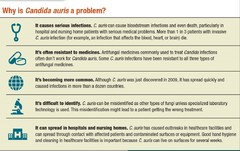Candida auris...
The NYT had an article today about this drug resistant fungal infection.
i thing drug resistant superbugs have been a growing problem, but Auris seems to be particularly alarming because of how quickly it has spread throughout the world.
Comments (8)
- lucillle thanked Zalco/bring back Sophie!
User
5 years agoI read they tested a hospital room for the fungus and they found it everywhere from the floor to the ceiling. That's scary.
lucillle thanked UserMDLN
5 years agolast modified: 5 years agoC. auris was first described in 2009.
Satoh K, Makimura K, Hasumi Y, Nishiyama Y, Uchida K, Yamaguchi H. Candida auris sp. nov., a novel ascomycetous yeast isolated from the external ear canal of an inpatient in a Japanese hospital. Microbiol Immunol 2009;53:41–4.
Concerns: (1) often multidrug-resistant, (2) difficult to identify and can be misidentified in labs, (3) has caused outbreaks in healthcare facilities.

Anglophilia
5 years agoThere are a lot of these bad "bugs" out there - this one is a fungus instead of a bacteria. Fortunately, it typically only is really harmful to the very young and the very old.
I have a chronic gram negative pulmonary infection that is very difficult to treat. One never truly gets "rid" of it, but one can keep it from colonizing - really "keeping it at bay". It only affects those who have bronchiectasis, who are mainly cystic fibrosis patients. I have non-CF bronchiectasis - only about 5% have this. I watch myself very carefully for any sign of colonization and immediately call my doctor for permission to re-start my inhaled antibiotic. Unfortunately for me, I have had adverse reactions to virtually all the oral antibiotics that help with this gram-negative bacteria, so inhaled is it. But it's very hard for me to tolerate it - causes me profound fatigue. I just keep using my inhaled saline twice daily - this keeps the congestion in my chest loose and so I can easily cough it up. It's when it stays in the lungs that it colonizes.
DawnInCal
5 years agoI had Candida Albicans (Thrush) a few years ago and it was absolute misery. My doctor gave me something for it (can't remember what) and it helped, but it never completely went away. While we were in Thailand on vacation, it came back with a vengeance. A pharmacist there recommended a drug (again can't remember what it was), but it was a two week course and he was very specific about finishing the course even if the infection seemed to have gone away. That got rid of it and I haven't had a sign of it since.
Lucille and mdln, are the two fungi similar to each other in how they affect people? There doesn't seem to be much information out there about Candida Auris as far as symptoms and treatment.
lucillle
Original Author5 years agolast modified: 5 years agoFrom the NYT article https://www.nytimes.com/2019/04/06/health/drug-resistant-candida-auris.html
Dr. Lynn Sosa, Connecticut’s deputy state epidemiologist, said she now saw C. auris as “the top” threat among resistant infections. “It’s pretty much unbeatable and difficult to identify,” she said.
Nearly half of patients who contract C. auris die within 90 days, according to the C.D.C.
From the CDC:
Candida auris Information for Patients and Family Members
Candida auris (C. auris) is a type of fungus that can cause serious illness in hospitalized patients. Infections with this fungus can be difficult to treat. C. auris only recently appeared in the United States, and public health officials are researching more about how it is spread. Here’s what you need to know if you or a family member have a C. auris infection.
What are the symptoms of C. auris infection?
- Symptoms may not be noticeable, because patients with C. auris infection are often already sick in the hospital with another serious illness or condition.
- Symptoms of C. auris infection depend on the part of the body affected. C. auris can cause many different types of infection, such as bloodstream infection, wound infection, and ear infection.
- Because symptoms can vary greatly, a laboratory test is needed to determine whether a patient has a C. auris infection.
Who is most likely to get C. auris infection?
- C. auris mainly affects patients who already have many medical problems.
- It often affects people who have had frequent hospital stays or live in nursing homes.
- C. auris is more likely to affect patients who have weakened immune systems from conditions such as blood cancers or diabetes, receive lots of antibiotics, or have devices like tubes going into their body (for example, breathing tubes, feeding tubes, catheters in a vein, or bladder catheters).
- Healthy people usually don’t get C. auris infections.
Are C. auris infections treatable?
- Most C. auris infections are treatable with a class of antifungal medications called echinocandins.
- Some C. auris infections have been resistant to all three main classes of antifungal medications, making them difficult to treat. In this situation, multiple antifungal medications at high doses may be needed to treat the infection.
How serious can C. auris infection be?
- Any invasive infection, which includes bloodstream infection with any Candida species, can be serious and even fatal.
- Many people who have died with C. auris had other serious illnesses that increased their risk of death.
Why does a patient with C. auris infection need special precautions during care?
- C. auris can spread from one patient to another in healthcare settings such as hospitals and nursing homes.
- Special precautions reduce the chance of spreading the fungus to other patients. These precautions include:
- Placing the patient in a room without a roommate.
- Wearing gowns and gloves when healthcare personnel care for the patient.
- Good hand hygiene for patients, family members, and healthcare personnel.
How long does a patient with C. auris need to be under these special precautions?
- Even after C. auris infection is treated, patients might continue to have C. auris on their skin or other body sites that doesn’t cause infection or illness but can still spread to other patients.
- For that reason, special precautions should continue as long the patient has C. auris on the skin or other body sites. The patient’s healthcare providers will determine when it is safe to stop these precautions.
Can a nursing home patient with C. auris participate in activities with others, such as meals or social gatherings, if they are on these special precautions?
In general, residents of nursing homes who have C. auris on their skin or other body sites or are sick with a C. auris infection can leave their rooms to attend meals and group functions if:
- They can wash their hands thoroughly on a regular basis.
- Wounds are bandaged to prevent any fluids from seeping out and infecting others.
- Other types of secretions like phlegm are contained.
- Items that residents touch often and shared equipment (for example, physical therapy equipment or recreational resources) should be cleaned and disinfected after use.
Can family members get sick?
- Family members who are healthy probably have a low chance of C. auris infection.
- C. auris is mainly a problem among people who are already sick with multiple medical problems and have spent a lot of time in healthcare settings.
- Family members and others caring for patients with C. auris should wash their hands thoroughly before and after touching the patient or touching medical devices.
- Handwashing is particularly important if the caregiver is caring for more than one ill person at home.
- Ask and remind healthcare personnel to wash their hands.
Should family members or other close contacts of patients be tested for C. auris?
- In most instances, CDC does not recommend that family members or other close contacts of patients with C. aurisinfections be tested for C. auris.
- However, if someone who has frequent contact with a patient with C. auris is admitted to a healthcare facility, a healthcare provider might test them for C. auris to determine if special precautions should be used.
What should people who have tested positive for C. auris do after being discharged from healthcare facilities?
People who have tested positive for C. auris should inform healthcare providers that they have tested positive for C. auriswhen visiting healthcare offices and when being admitted to hospitals and nursing homes.
CDC and state and local public health officials are concerned about C. auris infection and are working closely to track and control its spread.







maifleur01